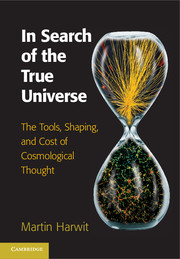Book contents
- Frontmatter
- Contents
- Preface
- Notes on Usage
- 1 The Nineteenth Century's Last Five Years
- Part I The Import of Theoretical Tools
- 2 An Overview
- 3 Conclusions Based on Principles
- 4 Conclusions Based on a Premise
- 5 Conclusions Based on Calculations
- 6 Ask the Right Questions, Accept Limited Answers
- Part II A National Plan Shaping the Universe We Perceive
- Part III The Cost of Discerning the True Universe
- Epilogue
- Appendix: Symbols, Glossary, Units and Their Ranges
- Index
- References
2 - An Overview
Published online by Cambridge University Press: 05 December 2013
- Frontmatter
- Contents
- Preface
- Notes on Usage
- 1 The Nineteenth Century's Last Five Years
- Part I The Import of Theoretical Tools
- 2 An Overview
- 3 Conclusions Based on Principles
- 4 Conclusions Based on a Premise
- 5 Conclusions Based on Calculations
- 6 Ask the Right Questions, Accept Limited Answers
- Part II A National Plan Shaping the Universe We Perceive
- Part III The Cost of Discerning the True Universe
- Epilogue
- Appendix: Symbols, Glossary, Units and Their Ranges
- Index
- References
Summary
The Universe We See Today
Twentieth century astrophysics has taught us that the origin and evolution of everyday matter, of the stars we see at night and the Universe we inhabit, share a coherent history dating back billions of years. Our knowledge remains fragmentary, but progress has been rapid and provides hope that our search will someday be complete, perhaps not in the sense that we will be all-knowing, but that we may have uncovered all that science can reveal.
One helpful feature in our search is that, as far back in time as we are able to probe, we find the known laws of physics holding firm. The speed of light, the properties of atoms, their constituent electrons and nuclei, and the mutual interactions of all these particles and radiation, appear unchanged ever since the first few seconds in the life of the Cosmos.
Also helpful has been that the Universe is expanding and that light, despite its high velocity, requires eons to cross cosmic distances. Using our most powerful telescopes we are able to directly view remote stars and galaxies, which emitted their light billions of years ago. We can compare how they appeared then and how stars and galaxies nearer to us in space appear now. And, as the Universe expands, light waves crisscrossing space expand with it.
- Type
- Chapter
- Information
- In Search of the True UniverseThe Tools, Shaping, and Cost of Cosmological Thought, pp. 9 - 24Publisher: Cambridge University PressPrint publication year: 2013



